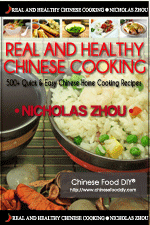



   
 


|

|
Home
>
Cooking Tips
>
The Five Elements
Theory of Chinese Cooking
The Five Elements Theory of
Chinese Cooking
|

Yin & Yang
|

|
|
|
|
"He that takes
medicine and neglects diet, wastes the skills of the
physician."
(Chinese proverb)
Like the concept of yin and yang, the Five
Elements Theory is at the cornerstone of Chinese
culture. What is the Five Elements Theory? The
Chinese believe that we are surrounded by five
energy fields: wood, fire, earth, metal, and water.
However, the elements are not static: they are
constantly moving and changing. (In fact, some
scientists think the term "element" is misleading,
and prefer to refer to the "five phases" or "five
forces.")
Once the Chinese identified the five elements,
they set about categorizing all phenomena within the
five categories. Everything, from a river to sounds
to the organs in our bodies, can be described in
terms of the five elements. How things are
characterized depends on their individual
qualities. For example, earth is associated with
growth and nourishment, so the spleen, which
monitors the blood - digesting debris and producing
antibodies when necessary - is categorized as an
earth element.
Just as an imbalance between yin and yang can
produce destructive forces, keeping all elements in
balance promotes harmony both in our surroundings
and ourselves. Of course, balancing five elements is
a little more complicated than achieving harmony
between two opposing forces. According to Chinese
belief, each element acts upon two others, either
giving birth to it or controlling it. For example,
wood gives birth to fire and controls or suppresses
earth. Similarly, fire gives birth to earth and
controls metal. All the elements are constantly
interacting with other elements - none stand alone.
The table below outlines the relationships.
| Gives Birth To |
Controlling |
| Wood - Fire |
Wood - Earth |
| Fire - Earth |
Earth - Water
|
| Earth - Metal |
Water - Fire |
| Metal - Water |
Fire - Metal |
| Water - Wood |
Metal - Wood |
To give an example from nature, a plant (wood) grows
when it is given water. When burnt, wood gives
birth to fire, and the burnt ashes subsequently
return to the earth.
What role does the Five
Elements Theory Play in the Chinese diet?
You'll see adherence to the five elements theory
in many facets of Chinese life. Martial arts, for
example: many schools have a series of basic
movements, each designed to keep the body in harmony
with one the elements. And the five elements theory
plays a large role in Feng Shui, the latest trend in
both landscaping and interior decorating. Literally
meaning "wind and water," Feng Shui is all about
aligning energies in your home or work environment
in a way that is most conducive with your own
personal energy.
As for diet, Chinese herbalists believe that, to
properly treat a patient, you must know the state of
the five elements in their body.
A deficiency or an excess of an element can lead to
illness. In The Chinese Kitchen:
Recipes, Techniques, Ingredients, History, and
Memories from America's Leading Authority on Chinese
Cooking, Eileen Yin Fei-Lo provides some
wonderful examples of how her grandmother used the
principles of the five elements theory to cure
common illnesses. Treating a cough with winter melon
tea and fresh water chestnuts is just one example.
A detailed look at the use
of five elements theory in diagnosing and treating
illnesses is beyond the scope of this article.
Suffice to say that practitioners of traditional
Chinese medicine rely on it to explain the
relationships between the body organs and tissues,
as well as between the body and the outside
environment. The table below outlines the
relationship between the five elements and body
parts, feelings, colors, and taste.
| Element |
Yin |
Yang |
Feelings |
Colors |
Tastes |
| Wood |
Liver |
Gall Bladder |
Rage |
Green |
Sour |
| Fire |
Heart |
Small Intestine |
Happiness |
Red |
Bitter |
| Earth |
Spleen |
Stomach |
Thought |
Yellow |
Sweet |
| Metal |
Lungs |
Large Intestine |
Sorrow |
White |
Spicy |
| Water |
Kidneys |
Bladder |
Fear |
Black |
Salty |
How would a physician use
the above information to make a diagnosis? Let's say
a patient suddenly developed a preference for sour
food. This could indicate liver problems. Of
course, the actual process of examining a patient
and making a diagnosis is much more complex than
merely consulting a chart. It requires a thorough
understanding of the interaction between all the
elements. Because time and date of birth are also
thought to play a role in an individual's "state of
the five elements," many physicians will consult
astrological charts before making a diagnosis.
 |
Get ready to
cook Chinese food?
Click here to see
500+ Real and Healthy Chinese Food Recipes
in 5 minutes! Plus 200+ cooking
tips and 170+ colorful pictures.
|
"500+ Healthy Chinese Recipes in 5 minutes"
|

|
ChineseFoodDIY's
cookbook "Real & Healthy Chinese Cooking" -
500+ low carb and low fat recipes with 170+ colorful pictures.
Based on a master chef's 40 years of cooking practice and 4 years of writing
and research, it has helped over 12,800 people worldwide improve
their health. All the secret copy cat recipes in ONE cookbook.
Click here to read the whole story that reveals how
ANYONE can cook delicious Chinese food and improve their health... in less than 20
minutes. | |
Related
Links:
Chinese Cooking Tips

|
|
|
|
|
|
|
|

|
|

|
|
